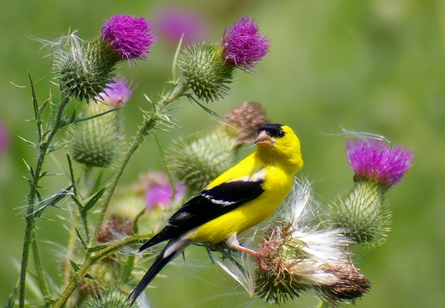SALT LAKE CITY — As summer heats up, the sight of blooming thistles may give male goldfinches a testosterone kick.

Thistle flowers could signal to American goldfinches that the seeds the songbirds prize for baby food and parent food will soon be abundant, proposes Thomas Luloff of the University of Western Ontario in London, Canada. And in lab setups, male goldfinches housed among blooming Canadian thistles underwent physiological changes that indicate the birds got the “breed now” message from the combination of summery heat and thrilling thistles, Luloff reported January 6 at the annual meeting of the Society for Integrative and Comparative Biology.
What particularly impressed George Bentley of the University of California, Berkeley was that the birds “don’t eat the flower — they eat the seeds,” he says. Yet the precursor to food still appeared to have an effect.
Biologists still have much to learn about what tips off birds that it’s time to breed, says Bentley, who was not part of the research project. Yet, he says, the need to understand those cues is growing as climate change threatens to knock signals out of sync.
Many birds lose what they don’t use during the winter, letting hormone concentrations dwindle and reproductive organs shrink. When the breeding season returns, both males and females typically have to recharge and regrow. Much of the earlier work on breeding signals has focused on the broad role of day length or temperature, yet birds can react to other cues too. Species differ in what cues or mixes of cues rev up their breeding biology again.
To see if just looking at thistle flowers would have an effect on goldfinch breeding, Luloff and his colleagues put wild goldfinches, caught during the nonbreeding season, into either of two temperature-controlled rooms. A series of shower curtains allowed birds in both rooms to see either pots of blooming thistles or nonblooming thistles, or no plants at all. Birds kept in the chill of Canadian spring at 13.5º Celsius during lab daytime didn’t experience a testosterone surge in response to thistles. But in the room warmed to a balmy 28º C, birds that could see pots of blooming thistles beside their cage developed twice the testosterone surge found in neighbors screened from blooms with a shower curtain and allowed to see only thistle plants without blooms.
In the warm room, the bloom-viewing males outpaced their bloomless neighbors in testes growth during the early stages of testes expansion. Later, though, the bloomless males caught up.
Bentley raises the question of whether the smell of the thistle blooms inspired the males. Luloff argues that he thinks it’s unlikely. Goldfinches don’t have much brain area known to be devoted to smelling, and anyway, the shower curtains may have blocked views but let odors circulate.
The idea of a visual food cue isn’t completely new, says reproductive biologist Heather E. Watts of Loyola Marymount University in Los Angeles. A 2000 study of antbirds found that the sight of mouthwateringly desirable live crickets affected the male songbirds’ physiology and increased their singing.






